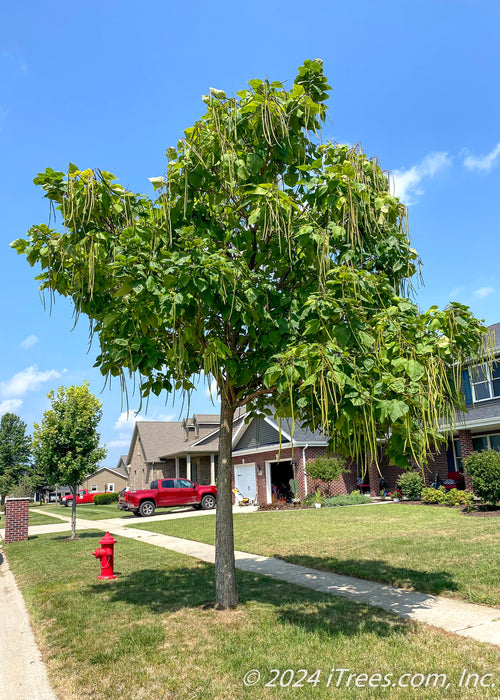

Why it rocks:
Northern Catalpa is a unique ornamental & flowering shade tree. This Midwest native is celebrated for its remarkable adaptability and breathtaking late spring blooms. Sometimes affectionately referred to as the Cigar Tree due to its distinctive long, slender pods that persist into winter, this tree features a bold, rugged branch structure that adds character to any landscape. As it matures, it gracefully develops an open, irregularly pyramidal form that enhances its visual appeal. From late spring to early summer, Northern Catalpa delights with clusters of fragrant, white, bell-shaped flowers reminiscent of orchids, each adorned with vibrant yellow-orange and purple centers. These enchanting blossoms are a magnet for essential pollinators and hummingbirds, making your landscape come alive! As autumn approaches, this tree’s canopy transforms beautifully from a rich medium green to a soft, gentle yellow. Its large, heart-shaped leaves provide ample shade while adding texture and depth to your outdoor space. This native gem serves as a distinctive ornamental shade tree option for those seeking to enhance their landscape with shade, beauty, and a hint of natural elegance.
Where to put it:
Northern Catalpa is a large tree that makes an excellent choice for spacious landscapes. Its striking appearance serves as a beautiful backdrop in more natural settings. This tree thrives near streams and ponds because it can tolerate slightly wet soils but can also grow in somewhat drier locations. It is a unique option for providing shade in open areas of front or backyards, as well as along wide residential boulevards. Northern Catalpa is commonly used in municipal plantings, specifically in wide medians city parks, and parkways. It also serves as a distinctive choice for cemeteries and golf courses. To optimize energy efficiency, consider planting this tree on the east, west, or northwest side of your home. When planting, it's important to position Northern Catalpa 18 to 20 feet away from nearby buildings to accommodate its full mature spread.
What it needs:
Northern Catalpa thrives in full sun and prefers moist, well-drained soil, although it can adapt to various landscape conditions. It is tolerant of different soil types found in the Chicagoland area, including dry sites and occasionally slightly saturated areas. This tree is also known for its salt tolerance, as well as its ability to withstand heat and drought. To promote a strong & healthy root system, please follow our tree care guidelines during the initial growing seasons.
| Botanical Name: | Catalpa speciosa |
|---|---|
| Hardiness Zone: | 5 |
| Tree Type: | Shade | Ornamental & Flowering |
| Size Range: | Large Tree (more than 40 feet) |
| Mature Height: | 50' |
| Mature Spread: | 35' |
| Shape: | Pyramidal | Rounded Crown |
| Foliage Color: | Medium Green |
| Fall Color: | Yellow/Gold |
| Flower Color: | White |
| Decorative Fruit: | Long Pods |
| Landscape Uses: | Shade | Parkway/Street |
| Growth Rate: | Rapid |
| Plant Tolerance: | Very Tough & Adaptable |
| Standout Feature: | Panicles of orchid-like white flowers, Large heart-shaped leaves, Native |
What is a Slow Release Watering Bag? It is a slow release watering system for newly planted trees. The slow release watering bag will slowly and ev...
View full detailsWhat is a DeWitt Tree Wrap?DeWitt Tree Wrap is made from polypropylene fabric and easily conforms to fit any tree shape or bark texture. Why use De...
View full details